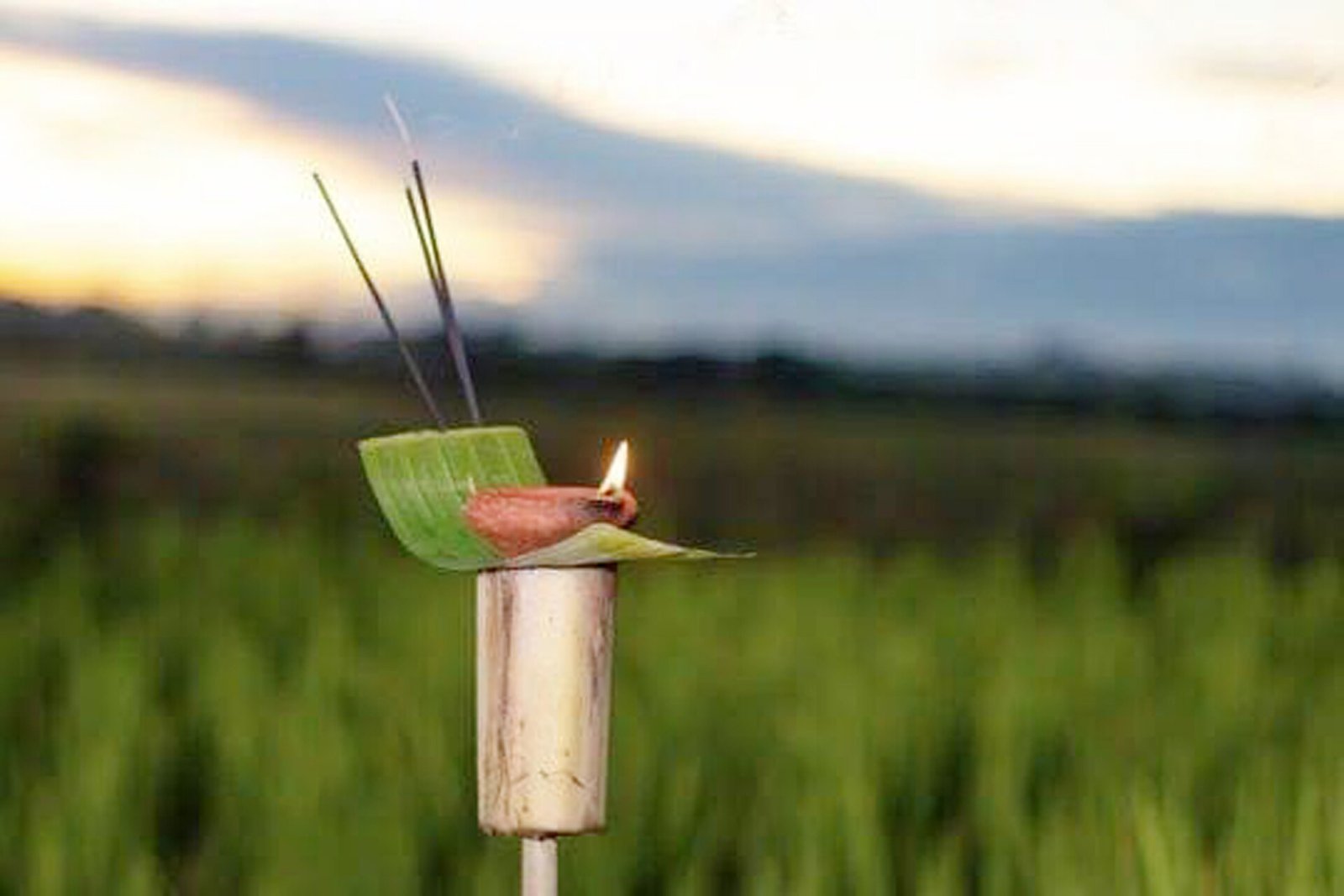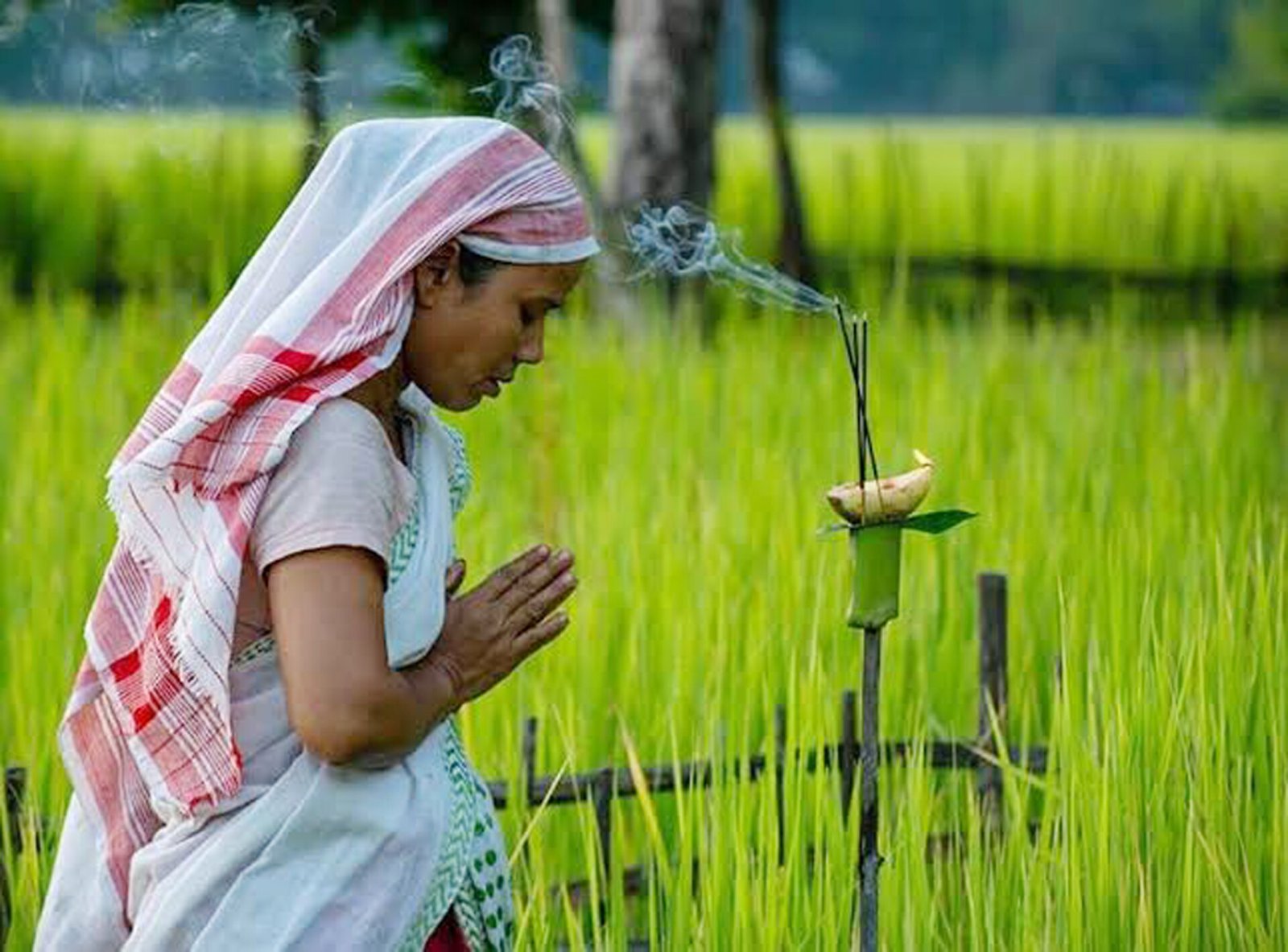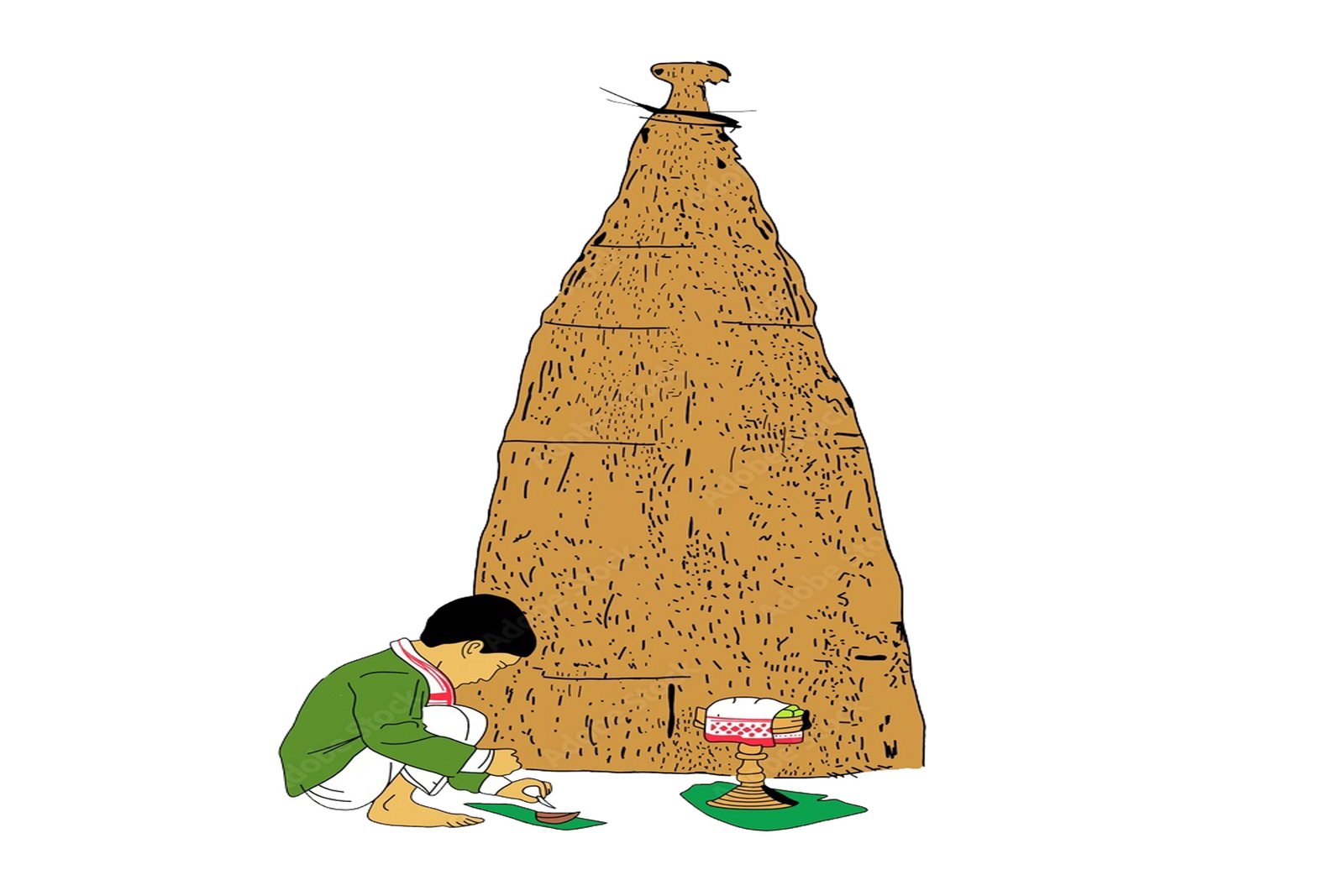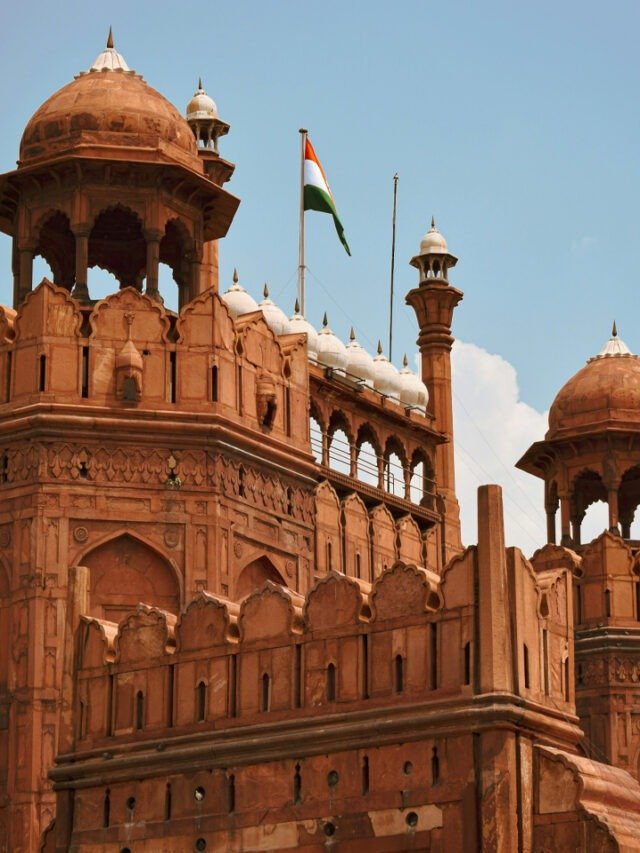By: Himangshu Ranjan Bhuyan
Kati Bihu, one of Assam’s three major Bihu festivals, is often overshadowed by its more exuberant counterparts, Bohag Bihu (Rongali Bihu) and Magh Bihu (Bhogali Bihu). While those two festivals are celebrations of fertility and harvest, marked by feasts, dance, and music, Kati Bihu presents a stark contrast. Also known as Kongali Bihu, or the “barren Bihu,” it is a time of quiet reflection and prayer, an intimate communion between farmers and their land, during a period of agricultural uncertainty.
Kati Bihu is celebrated in mid-October, aligning with the Assamese month of Kati. This is a time when rice fields stand tall with crops that are yet to mature. The festival occurs during the waiting period, a time of hope tempered by caution, as the yield of the crop is still unknown. Resources are often scarce at this time, with granaries running low from last year’s harvest, and farmers rely on their faith and perseverance to see them through this crucial phase. Kati Bihu serves as a reminder of the fragile balance between human labor and nature’s will, with rituals and prayers being the core of this agrarian festival.
Unlike the festive celebrations associated with other Bihus, Kati Bihu carries a more somber tone. The mood in rural Assam during this period is pensive rather than celebratory. It is a time when farmers, having sown their fields and tended to their crops, must now step back and leave the fate of their harvest to nature. This phase of uncertainty is reflected in the simple, introspective rituals of Kati Bihu. While Rongali Bihu is about fertility and new beginnings, and Bhogali Bihu is about harvest and feasting, Kati Bihu is about patience, faith, and quiet resilience.
One of the most significant rituals of Kati Bihu is the lighting of the Akash Banti, or sky lamp. Small earthen lamps, filled with oil, are placed on tall bamboo poles in the fields and around homes. These lamps are lit at dusk, and their flickering flames glow softly in the darkness of the night, symbolizing hope and guiding the spirits of ancestors. In the context of Kati Bihu, the Akash Banti is not just a light in the physical sense but a metaphor for the hope that farmers carry in their hearts during this uncertain time. The lamps are also believed to protect the fields from evil forces and to ward off pests that could potentially damage the crop.
The significance of the Akash Banti goes beyond its function as a ritualistic object. It embodies the relationship between the farmer and the land, a relationship that is marked by both hard work and humility. By lighting these lamps, farmers acknowledge that, despite their best efforts in tending to their crops, the final outcome is beyond their control. The lamps are offerings to the divine, a way of seeking blessings for the crops that have been sown. They represent the farmer’s faith in the forces of nature and the hope that all will go well in the weeks leading up to the harvest.
The ritual of lighting the Akash Banti is often accompanied by the chanting of prayers and the offering of food to the spirits of the ancestors. These prayers are a quiet plea for protection and prosperity. Farmers believe that their ancestors, who too were connected to the land, will guide and protect them, ensuring that the crops grow well and the harvest is bountiful. This act of offering underscores the deep connection that Assamese farmers have with both their heritage and their land. The act of remembering one’s ancestors and seeking their blessings is a humble recognition of the cyclical nature of life, where past, present, and future are all intertwined.
Another important aspect of Kati Bihu is the worship of the Tulsi plant, which holds a special place in Assamese households. Tulsi, revered in Hinduism for its medicinal and spiritual properties, is worshipped in the evening during Kati Bihu. Farmers light small lamps and place them near the Tulsi plant, offering prayers for the health and well-being of their family and crops. The Tulsi plant symbolizes life, fertility, and protection, and its worship during Kati Bihu reflects the farmer’s deep respect for nature. Just as the Tulsi plant is nurtured and protected, so too are the crops in the fields, which require care and attention to thrive.
The worship of Tulsi during Kati Bihu also highlights the theme of domesticity that runs through the festival. While the fields are a place of hard work and hope, the home is a space of prayer and reflection. The lighting of lamps around the Tulsi plant signifies the farmer’s acknowledgment of the interconnectedness between home and field, between the domestic and the agrarian. The act of worshipping Tulsi is a reminder that, in the life of a farmer, the personal and the professional, the spiritual and the material, are all deeply connected. The well-being of the family and the success of the harvest are seen as two sides of the same coin.
Kati Bihu also marks the beginning of a period of transition. As the festival falls during a time when the rice plants are still maturing, it is a period of waiting and watching. Farmers monitor their fields closely, ensuring that no harm comes to the crops during this delicate phase. The quiet rituals of Kati Bihu – lighting lamps, offering prayers, worshipping the Tulsi plant – are all ways in which farmers seek to protect their crops and ensure a good harvest. It is a time of introspection, when farmers are reminded of their dependence on the forces of nature and their own resilience in the face of uncertainty.
In many ways, Kati Bihu is a reflection of the agrarian life in Assam, where farming is not just an occupation but a way of life. The festival encapsulates the values of patience, faith, and hard work that define the life of a farmer. It is a time to pause, reflect, and offer prayers for a successful harvest, while also acknowledging the risks and challenges that come with farming. The simplicity of the rituals – lighting lamps, offering prayers, worshipping Tulsi – mirrors the simplicity of the agrarian lifestyle, where life is lived in harmony with the cycles of nature.
Kati Bihu also serves as a reminder of the deep connection between the people of Assam and their land. Agriculture has always been the backbone of Assamese society, and the rhythms of rural life are closely tied to the cycles of planting and harvesting. The rituals of Kati Bihu reflect this connection, offering a glimpse into the lives of farmers who rely on the land for their sustenance and livelihood. The festival is not about grand celebrations or material abundance; instead, it is about honoring the land and offering quiet prayers for its fertility and protection.
As modernity and urbanization continue to reshape the landscape of Assam, the celebration of Kati Bihu has evolved as well. In urban areas, where agriculture is no longer the primary source of livelihood, the rituals of Kati Bihu have taken on a more symbolic significance. The lighting of the Akash Banti, the worship of Tulsi, and the offering of prayers are still observed, but the direct connection to farming is less immediate. Nonetheless, Kati Bihu remains an important cultural festival, serving as a reminder of Assam’s agricultural heritage and the values of patience, faith, and perseverance that are embedded in the region’s identity.
Kati Bihu may not have the festive exuberance of its counterparts, but its quiet rituals and solemn prayers speak to the heart of Assamese culture. It is a festival that honours the land, the cycles of nature, and the resilience of the farmers who depend on it. Through the lighting of lamps and the offering of prayers, Kati Bihu reflects the deep spiritual connection between the people of Assam and the land they cultivate. It is a time of waiting, watching, and hoping, a time when farmers place their faith in the forces of nature and offer quiet prayers for a bountiful harvest.
In a world where agriculture is becoming increasingly industrialized and disconnected from the rhythms of nature, the rituals of Kati Bihu offer a valuable reminder of the importance of humility, patience, and respect for the land. The quiet prayers of Assam’s farmers, offered in the soft glow of the Akash Banti, remind us that farming is not just about production and consumption – it is about living in harmony with nature, understanding its cycles, and honoring its gifts. Kati Bihu, in its quiet way, keeps this spirit alive, offering a moment of reflection and gratitude for the land that sustains us. (The writer is Editor in Chief of the Assamese E-Megazine SAMPROTIK. He can be reached at himangshur1989@gmail.com)












